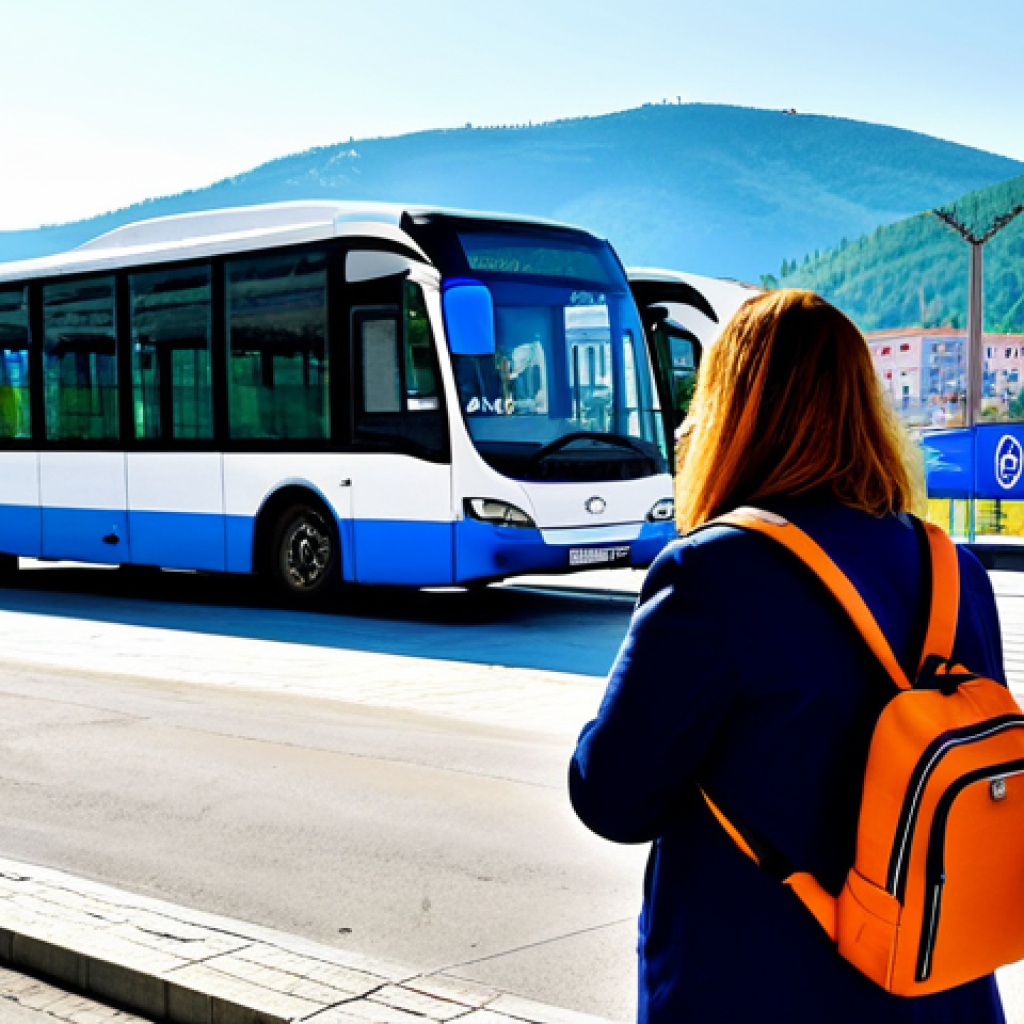Stepping foot into Bosnia, the allure of exploring its vibrant culture and then hopping over to neighboring gems like Croatia or Montenegro is undeniable.
But as someone who’s navigated these routes countless times, I can tell you that figuring out the most efficient and comfortable cross-border transport isn’t always straightforward.
With the Balkans becoming an increasingly hot spot for travelers seeking authentic experiences, and as digital nomads look for more accessible hubs, understanding the nuances of local buses, emerging ride-share options, or even the sparse train networks becomes paramount.
It’s a blend of old-world charm meeting modern challenges, especially with border formalities evolving. Curious about how to master your journey? Let’s dive deeper and find out exactly.
Decoding Balkan Border Crossings: My Hard-Earned Insights

Stepping foot into Bosnia, the allure of exploring its vibrant culture and then hopping over to neighboring gems like Croatia or Montenegro is undeniable. But as someone who’s navigated these routes countless times, I can tell you that figuring out the most efficient and comfortable cross-border transport isn’t always straightforward. With the Balkans becoming an increasingly hot spot for travelers seeking authentic experiences, and as digital nomads look for more accessible hubs, understanding the nuances of local buses, emerging ride-share options, or even the sparse train networks becomes paramount. It’s a blend of old-world charm meeting modern challenges, especially with border formalities evolving. Curious about how to master your journey? Let’s dive deeper and find out exactly. From my very first tentative journey across the Bosnian-Croatian border near Neum, where I wasn’t quite sure if my passport was going to be stamped correctly, to more recent, smooth transitions, I’ve seen it all. The key, I’ve learned, isn’t just about picking a mode of transport; it’s about understanding the rhythm of the region, embracing the unexpected, and always, always having a backup plan. There’s a certain magic to the journey itself in the Balkans, a feeling of truly moving between worlds, and with a little preparation, you can make that experience as seamless and enjoyable as possible. This isn’t just theory; these are the lessons I’ve learned through countless miles and a few unexpected detours.
1. The Unsung Hero: Navigating Intercity Buses
For me, the bus has always been the workhorse of Balkan travel. It’s not glamorous, certainly, but it’s often the most reliable and affordable way to get from point A in Bosnia to point B in Croatia or Montenegro. I remember one particularly long journey from Mostar to Split; the bus was old, the air conditioning was questionable, but the views were breathtaking, and the camaraderie among passengers was genuine. We shared stories, snacks, and even a few laughs during an unexpected border delay. You’ll find a surprising number of routes connecting major cities like Sarajevo, Banja Luka, and Mostar with Dubrovnik, Split, and Podgorica. Always try to buy your tickets a day or two in advance, especially during peak season, as I’ve been caught out before, standing awkwardly at a bus station in the heat with no seats left. Look for companies like Centrotrans or Globtour for routes heading out of Bosnia; they tend to have better schedules and more frequent departures. Don’t expect luxury, but do expect an authentic slice of local life, complete with the occasional spontaneous stop for a coffee or a quick stretch. The bus station itself can be chaotic, so arrive early and keep your eyes peeled for your bus number – they don’t always announce departures very clearly!
2. Border Formalities and Unexpected Delays
Ah, border crossings! This is where the real adventure often begins. My first time crossing into Croatia from Bosnia by bus, I was so nervous about the passport control process. What if I said the wrong thing? What if they asked me something in a language I didn’t understand? Turns out, it’s usually straightforward, but patience is your best friend. Buses will stop, everyone disembarks with their passports, and you queue up. Sometimes it’s quick, other times it feels like an eternity, especially if multiple buses arrive at once. I’ve personally experienced delays ranging from 20 minutes to over 2 hours, particularly at the Neum corridor or when entering Montenegro. Make sure your passport is valid for at least six months beyond your intended stay and that you have any necessary visas. EU citizens typically have a smoother time, but non-EU travelers should double-check specific country requirements. It’s also wise to have a printout of your accommodation booking or onward travel plans, just in case they ask. I learned this the hard way when a border agent once questioned my intentions; luckily, I had my hotel reservation on my phone. Stay calm, be polite, and have all your documents ready. A friendly smile goes a long way, believe me.
Embracing the Open Road: Cars, Rideshares, and the Freedom They Offer
There’s a special kind of liberation that comes with having your own wheels in the Balkans. After several bus trips, I finally decided to rent a car for a multi-country adventure, starting in Sarajevo and winding through Montenegro before ending in Croatia. The freedom to pull over at a scenic viewpoint, discover a hidden village, or simply stop for a coffee at a roadside cafe when the mood strikes is unparalleled. However, it’s not without its challenges. Roads in Bosnia can be narrow and winding, and while major routes are generally well-maintained, some rural roads can be a bit rough. Driving etiquette also varies; be prepared for confident overtakes and local drivers who know the roads like the back of their hand. I always recommend getting full insurance, including a green card for international travel, which is often required when crossing borders. I’ve heard too many stories of minor fender benders turning into major headaches due to inadequate insurance. Also, having a good GPS (or even just Google Maps downloaded offline) is a lifesaver, as road signs can sometimes be sparse or confusing, especially when transitioning between different alphabets. My personal experience has taught me that the initial cost of a rental car is quickly justified by the sheer flexibility and depth of exploration it allows.
1. Renting a Car: Freedom with a Few Quirks
Renting a car in Bosnia gives you immense flexibility, but be aware of the specific rules and requirements. Most major rental agencies operate in Sarajevo and other larger cities, offering a range of vehicles. When I rented my first car, I was careful to check for the green card insurance, which is absolutely crucial for crossing borders into Montenegro and Croatia. Without it, you could face significant issues at the border, or even be denied entry. Some rental companies might charge an extra fee for cross-border travel, so always clarify this upfront. I once had a small scare when the rental company forgot to include the green card details on my paperwork, and I had to frantically call them from the border to get it sorted via email. It taught me to always double-check everything before leaving the rental office. Parking can be a bit challenging in older city centers, so look for designated parking garages or lots. Fuel prices are generally reasonable, but keep an eye out for gas stations in more remote areas, as they can be few and far between. Driving through the mountains of Montenegro in my rental car, pulling over to admire the views of the Bay of Kotor, truly felt like an authentic, unforgettable adventure.
2. Ride-Sharing and Private Transfers: A Growing Trend
While formal ride-sharing apps like Uber are limited outside of Croatia’s major tourist hubs, private transfers and informal ride-sharing groups are increasingly popular, especially for travelers looking for more comfort or direct routes. I’ve used local taxi services for shorter cross-border trips, like from Trebinje to Dubrovnik, which can be surprisingly affordable if you negotiate the fare beforehand. For longer journeys, I’ve found success by asking my guesthouse host for recommendations on private drivers. There’s a growing network of independent drivers who offer services, often with nicer vehicles and more personalized itineraries. While not as structured as a global ride-share app, these informal arrangements often provide a much more comfortable and direct journey than a bus. I once shared a private transfer from Sarajevo to Podgorica with another traveler I met at my hostel, splitting the cost made it quite economical, and the driver was full of local insights. It’s a fantastic option if you’re traveling with a group or have specific luggage requirements, but always agree on the price before you start the journey to avoid any misunderstandings. This option often saves time at borders as well, as smaller vehicles tend to move through customs quicker than large buses.
The Train: A Scenic, Yet Limited, Option Across the Balkans
When I first looked into train travel in the Balkans, I was imagining romantic, slow journeys through picturesque landscapes, reminiscent of old travelogues. And while the scenery can indeed be stunning, particularly on the Sarajevo-Mostar route within Bosnia, the cross-border train network is, unfortunately, quite sparse. It’s certainly not the extensive network you might find in Western Europe. I tried to plan a train journey from Bosnia into Croatia once, only to discover that the direct lines are few and far between, and often require multiple changes or bus transfers at certain points. The infrastructure simply isn’t as developed for international rail travel. If you’re looking for efficiency or speed, trains generally won’t be your top choice for crossing borders here. However, if you’re a rail enthusiast or simply looking for a unique, leisurely way to experience the landscape, then by all means, explore the available routes. Just manage your expectations regarding frequency and direct connections. The journey itself can be a charming step back in time, offering a different perspective on the region’s diverse scenery. I loved the old-school feel of the train carriages, and the chance to simply gaze out the window without worrying about navigation.
1. Limited International Rail Connections
While Bosnia has some domestic train lines, direct international train connections to neighboring countries are remarkably limited. For example, there’s no direct train from Sarajevo to Split or Dubrovnik, or even to Podgorica in Montenegro. Most train journeys would involve multiple changes, often at smaller, less convenient stations, and might still require a bus or taxi connection at the border itself. The most famous international line used to be between Sarajevo and Ploče (Croatia), but this service has often been suspended or operates only seasonally, so it’s essential to check the latest schedules and operational status directly with the railway companies before planning. I recall the frustration of trying to piece together a train itinerary that just didn’t exist in a practical sense. It’s a shame, as the potential for scenic rail travel through the Dinaric Alps is immense. For now, consider train travel more for internal Bosnian exploration, like the breathtaking Sarajevo to Mostar line, rather than a primary mode for crossing international borders. This is truly an area where the bus or car reigns supreme for practicality.
2. The Charm of Local Trains (Within Bosnia)
Even though international train options are limited, taking a local train within Bosnia can be a truly charming experience. The journey from Sarajevo to Mostar, for instance, is often cited as one of Europe’s most scenic rail routes. It winds through dramatic canyons, alongside turquoise rivers, and offers views that simply aren’t possible from the road. I took this train once, purely for the experience, and it was unforgettable. The carriages were old, but comfortable enough, and the pace was wonderfully slow, allowing me to truly absorb the beauty of the landscape. It’s a fantastic way to slow down, connect with locals, and witness the raw, untamed nature of Bosnia. While it won’t get you directly to Croatia or Montenegro, it’s an experience I highly recommend adding to your Bosnian itinerary if you have the time and are looking for a unique perspective on the country’s interior. Just remember to pack some snacks and a good book, as these journeys are about the ride, not necessarily the speed.
Essential Preparations for Seamless Border Crossings
Crossing international borders, even within Europe, can be daunting if you’re unprepared. From my numerous experiences, the difference between a smooth transition and a stressful ordeal often comes down to a few key preparations. It’s not just about having your passport, though that’s obviously paramount. I’ve learned to anticipate potential questions from border guards, pack essential documents strategically, and even mentally prepare for the inevitable waiting periods. My advice is always to over-prepare rather than under-prepare; it saves a lot of headaches and anxiety down the line. I once saw a traveler at the Montenegrin border completely caught off guard by a question about their onward travel, leading to a long delay. Don’t let that be you! Take a few moments before your journey to gather all necessary paperwork and familiarize yourself with the process. A little bit of foresight can genuinely transform your border crossing experience from a chore into a mere formality, letting you focus on the excitement of reaching your next destination.
1. Documents You Can’t Afford to Forget
Beyond your passport, there are a few documents you absolutely must have ready. First, and this might sound obvious, ensure your passport is valid for at least six months beyond your planned departure date. I’ve personally seen people turned away for this. If you’re driving a rental car, you need the vehicle registration, insurance papers (including the green card for international travel), and your international driving permit (if required for your nationality). For bus travel, your ticket is your golden pass. I also always carry a printout or digital copy of my onward travel tickets (bus, train, or flight) and my accommodation bookings for at least the first night in the new country. While not always requested, these can be crucial if a border agent asks about your travel plans or financial means. I also keep a physical copy of my travel insurance details, just in case. Having all these readily accessible in a designated folder or digital file on your phone will save you a lot of fumbling and stress at the border checkpoint. It’s all about being prepared and looking organized; it makes the process quicker for everyone involved.
2. Tips for a Smoother Border Experience
Here are a few nuggets of wisdom I’ve picked up over the years for making border crossings less painful. Firstly, always fill out any customs declarations or entry forms clearly and completely. Don’t rush. Secondly, if you’re traveling by bus, keep your passport handy – don’t bury it deep in your luggage! When the border agent approaches, have it open to the photo page. Thirdly, be polite and respectful to border officials; a simple “dobar dan” (good day in Bosnian/Croatian/Serbian) can go a long way. Avoid making jokes or being sarcastic; they’re just doing their job. If you’re asked a question, answer truthfully and concisely. Don’t volunteer extra information they haven’t asked for. Lastly, pack a snack and a water bottle, especially if you’re on a bus. Delays happen, and being hungry or thirsty only adds to the frustration. I’ve often seen people get agitated, which never helps. Just accept that sometimes you’ll wait, and use the time to people-watch or catch up on some reading. Patience is truly a virtue when navigating Balkan borders. And remember, keep your luggage with you if you exit the bus at the border; don’t assume it will be safe inside the bus during inspection.
Budgeting and Unexpected Costs for Cross-Border Travel
Traveling on a budget is always a key consideration, and cross-border journeys can sometimes throw in unexpected costs if you’re not careful. I’ve personally learned to factor in everything from the “green card” insurance for car rentals to the small, often cash-only, baggage fees some bus drivers demand. It’s easy to get caught out, and I’ve certainly had moments where a seemingly cheap bus ticket suddenly felt a lot more expensive after a few hidden charges surfaced. The beauty of the Balkans is that it’s generally more affordable than Western Europe, but that doesn’t mean you should ignore the financial planning aspects. Being aware of these potential extra costs means you can allocate your budget more effectively and avoid any unpleasant surprises that might dampen your travel spirit. From my perspective, a little proactive financial planning goes a long way in ensuring a stress-free and enjoyable cross-border adventure through this incredible region. Always carry a mix of cash and card, as some smaller establishments, especially in rural areas, might not accept cards.
1. Anticipating Hidden Fees and Local Payments
One of the first things I learned about bus travel in the Balkans is the often-unadvertised baggage fee. It’s usually a small amount, typically 1-2 EUR or local currency equivalent per bag placed in the hold, but it’s almost always cash only. I’ve seen travelers caught completely off guard, frantically searching for coins. So, always have a small stash of local currency (BAM in Bosnia, HRK in Croatia, EUR in Montenegro) available when you board the bus. Another common ‘hidden’ cost for car rentals is the cross-border fee; some agencies charge an additional daily rate for taking the car into another country, even if the green card is included. Make sure to inquire about this explicitly when booking. Exchange rates can also eat into your budget if you’re not careful; I always use ATMs associated with major banks to get local currency rather than relying on airport exchange kiosks, which often have terrible rates. For example, when converting from BAM to HRK, a slight difference in the exchange rate can add up quickly over several transactions. It’s all about being smart with your money and anticipating these small, yet impactful, additional expenses.
2. Cost Comparison: Buses vs. Cars vs. Private Transfers
To give you a better idea of what to expect, here’s a quick overview based on my own experience with typical costs. Keep in mind these are approximate and can vary wildly based on season, route, and booking time. This table reflects general trends for common cross-border routes, giving you a baseline to plan your budget. I often find that while buses are cheapest per person, car rentals become more economical for groups of 3-4, offering much greater flexibility, and private transfers are excellent for convenience if budget isn’t the primary concern.
| Transport Method | Approx. Cost (per person/day) | Pros | Cons |
|---|---|---|---|
| Intercity Bus | €15-€40 (one-way ticket) | Most economical, extensive network, local experience | Fixed schedules, potential delays, baggage fees |
| Rental Car | €30-€80 (per day, excl. fuel/insurance) | Ultimate flexibility, scenic routes, good for groups | High cost for solo, parking challenges, complex insurance |
| Private Transfer/Taxi | €50-€150 (per trip, route dependent) | Convenience, door-to-door, faster border crossing | Highest cost, less spontaneous, requires pre-booking |
| Train | €5-€20 (domestic/limited intl. segments) | Scenic, unique experience, often comfortable | Very limited international routes, slow, infrequent |
Navigating Connectivity and Communication Across Borders
Staying connected while hopping between Bosnia, Croatia, and Montenegro can sometimes feel like a mini-challenge, especially if you’re used to seamless roaming across larger zones like the EU. I remember my first trip, naively assuming my mobile plan would just work everywhere, only to find myself frantically searching for Wi-Fi or a local SIM card when my data suddenly cut out at a border. It’s easy to overlook this aspect when planning your journey, but reliable internet access can be a lifesaver for navigation, checking bus schedules, communicating with accommodation hosts, or even just keeping in touch with loved ones back home. My personal rule of thumb now is to always consider how I’ll stay connected before I even leave my starting point, because nothing is more frustrating than being lost in a new city with no access to maps or information. A little planning here can save a lot of stress and ensure you’re always just a few taps away from the information you need, whether it’s confirming a hostel booking or finding the nearest ATM.
1. Mobile Data: Roaming vs. Local SIM Cards
This is where things can get a little tricky, and it’s a common trap for many travelers. While Croatia is part of the EU and typically falls under EU roaming regulations (meaning your EU SIM card will work there at no extra cost), Bosnia and Montenegro are not. This means that if you have an EU SIM, your data costs can skyrocket the moment you cross into Bosnia or Montenegro. I learned this the hard way when I got a bill full of unexpected roaming charges! My advice, based on countless trips, is to either invest in an international roaming package from your home provider (check costs carefully!) or, more economically, purchase local SIM cards in each country. Local SIMs are relatively cheap and easy to acquire in Bosnia and Montenegro, offering decent data packages. Look for providers like BH Telecom or M:tel in Bosnia, and Crnogorski Telekom or Telenor in Montenegro. They typically have kiosks at airports or in city centers. While it means swapping SIMs, it’s usually the most cost-effective solution for longer stays in non-EU countries. Always remember to unlock your phone before you travel if you plan to use local SIMs!
2. Wi-Fi Availability and Emergency Contacts
While local SIM cards are great for constant connectivity, Wi-Fi is generally widely available in cities. Most hotels, guesthouses, restaurants, and cafes offer free Wi-Fi, which can be a good backup or primary method of staying online if you’re not planning extensive use of mobile data. I always try to download offline maps (Google Maps allows this) for the areas I’m visiting, just in case I find myself without a signal or Wi-Fi. It’s a literal lifesaver when you’re trying to navigate unfamiliar streets. Furthermore, it’s crucial to have a list of emergency contacts readily accessible, both digitally and physically. This includes local emergency numbers (112 in most of the Balkans for general emergencies), your embassy’s contact details, and perhaps your travel insurance emergency line. I also make sure to share my itinerary with a trusted friend or family member back home, including my planned border crossings. Being prepared for the unexpected, even a simple dead phone battery, can make all the difference in a potentially stressful situation. Always prioritize your safety and ensure you have ways to reach out if needed.
Closing Thoughts
My countless journeys across the Balkan borders, with all their quirks and charms, have taught me that true adventure often lies in embracing the unexpected.
While the logistical details might seem daunting at first, with a bit of foresight and the right mindset, these transitions become seamless parts of an unforgettable experience.
The joy of discovering hidden gems, connecting with locals, and witnessing the breathtaking landscapes makes every border stamp worth it. From my very first nervous crossing to now navigating them with ease, I’ve found that the Balkans offer a unique blend of challenge and reward, leaving you with stories and memories that last a lifetime.
So pack smart, stay informed, and get ready to unlock the magic of this incredible region.
Useful Information to Know
1. Always carry small denominations of local currency (BAM in Bosnia, HRK in Croatia, EUR in Montenegro) for bus baggage fees, small purchases, or tipping. Many smaller establishments, especially in rural areas, are cash-only, and larger bills might be difficult to break.
2. Learn a few basic phrases like “Dobar dan” (Good day), “Hvala” (Thank you), and “Molim” (Please/You’re welcome). Locals truly appreciate the effort, and it can often smooth interactions, especially at bus stations or local markets.
3. Utilize online resources for checking bus schedules and booking tickets in advance. Websites like BusTicket4.me, GetByBus, or even Rome2Rio can be invaluable for planning your intercity and cross-border bus journeys, saving you time and potential stress at busy terminals.
4. Be mindful of local driving habits if you’re renting a car; Balkan drivers can be quite assertive. Stay vigilant, stick to speed limits, and always be aware of your surroundings, especially on winding mountain roads or in city traffic.
5. Consider traveling during the shoulder seasons (April-May or September-October) to avoid the peak summer crowds and intense heat. You’ll often find better deals on accommodation and transportation, and the weather is generally more pleasant for exploring.
Key Takeaways
Navigating the captivating Balkan region, particularly across its borders, truly becomes an enriching experience with the right approach. Prioritize your documentation by ensuring your passport is valid and having copies of all essential travel papers, including vehicle insurance (green card) if driving, and onward travel/accommodation bookings.
Buses are your most reliable and economical option for intercity and international travel, though be prepared for potential baggage fees and border delays.
Renting a car offers unparalleled freedom, justifying the higher cost for those seeking extensive exploration. While international train connections are limited, local trains within Bosnia provide unique, scenic journeys.
Always secure your mobile connectivity through local SIM cards in non-EU countries like Bosnia and Montenegro to avoid high roaming charges. Lastly, patience, politeness, and a flexible mindset are your best companions, allowing you to embrace the minor hurdles as part of the authentic Balkan adventure.
Frequently Asked Questions (FAQ) 📖
Q: What’s truly the best way to get between, say, Sarajevo and Dubrovnik, or Podgorica, without pulling my hair out?
A: Oh, this is the million-dollar question, isn’t it? After countless trips navigating these specific routes, I can tell you straight up: the bus is your absolute workhorse here.
Forget trains; they’re practically non-existent for efficient cross-border travel in this part of the Balkans, almost like a charming relic from a bygone era that just doesn’t quite connect up anymore.
Ride-sharing apps like BlaBlaCar? They exist, but honestly, it’s a bit of a gamble. You might find a great ride with a local, but then again, you might not find anything at all for your specific route or on your schedule.
I’ve been stranded, waiting, hoping, only to give up and head to the bus station. So, yeah, the humble bus reigns supreme. Now, while they aren’t always luxurious – think comfy but not plush seats, maybe a slight lack of legroom for taller folks like me, and often no Wi-Fi that actually works for more than five minutes – they are surprisingly reliable for getting you from A to B.
They run frequently, cover pretty much every major town and city across Bosnia, Croatia, and Montenegro, and are generally quite affordable. I recall one particularly scenic route from Mostar to Kotor, winding through the mountains and along the coast; I just leaned back, put on some music, and let the incredible landscape wash over me.
It was slower than driving myself, sure, but also infinitely less stressful. Just remember to have some local currency ready (like Bosnian Convertible Marks or Croatian Kuna, though Euros are widely accepted in Montenegro and increasingly in tourist spots elsewhere) for that small luggage fee they often charge at the bus’s undercarriage – it always catches newbies by surprise!
Q: I’ve heard border crossings can be a nightmare. What’s the real deal with formalities and how do I navigate them smoothly?
A: “Nightmare” is a strong word, but I get why people say it! It’s less a nightmare and more a proper test of patience. My heart sinks a little every time the bus pulls up to a border post, because you just never know how long it’s going to take.
Generally, it goes like this: the bus stops, the driver or a border official collects everyone’s passports – yeah, all of them, in a big stack – and disappears into the customs office.
You just sit there, sometimes for twenty minutes, sometimes for two hours, just… waiting. I’ve seen people pace, seen them sleep, seen them scroll through their phones until the battery dies.
My advice? Have your passport ready and easily accessible. Don’t hide it under a pile of clothes in your backpack.
Keep your cool. There’s absolutely nothing you can do to speed up the process. Engaging with the border officials unnecessarily is a no-go; they’re just doing their job.
I once saw a tourist get really agitated, and it just made everything slower. Just breathe. Bring snacks, water, a fully charged phone, maybe a book.
Some borders, like between Bosnia and Croatia, can feel more stringent due to Croatia being in the EU, while others, like between Bosnia and Montenegro, might feel a bit more relaxed.
It’s truly a mixed bag, and the wait times can fluctuate wildly depending on the time of day, season, or just… inexplicable Balkan bureaucracy. So, no magic bullet, just patience and preparation.
Q: How do I actually book these tickets? Can I do it online, or am I stuck trying to haggle at the bus station?
A: Ah, the booking process! This is where that “blend of old-world charm meeting modern challenges” really hits home. For major routes and well-known carriers, especially if you’re going into or out of Croatia, you can often book tickets online.
Websites like BusTicket4.me or GetByBus have made things a lot easier than they used to be. It’s convenient, and you can secure your spot without stress.
I’ve definitely used them for peace of mind, especially during peak season. However, and this is a big “however,” for smaller routes, or if you’re in a more remote town, or even if you just prefer to have a physical ticket in your hand, buying directly at the bus station is still king.
I’ve had experiences where an online booking system was quirky, or a minor local bus line simply wasn’t listed. Plus, buying at the station means you can ask questions – even if it’s with gestures and broken English on both sides – and often confirm the exact departure gate.
Sometimes, it’s also cash only, so don’t just rely on your card. I once arrived at a tiny bus station in Bosnia, totally expecting to pay with my card after seeing online it was possible, only to be met with a firm “Cash only!” and had to scramble to find an ATM.
It taught me to always have some local notes tucked away, just in case. So, my rule of thumb is: check online first, but always, always be prepared to head to the station and buy your ticket in person.
It’s part of the adventure, honestly!
📚 References
Wikipedia Encyclopedia
구글 검색 결과
구글 검색 결과
구글 검색 결과
구글 검색 결과
구글 검색 결과





